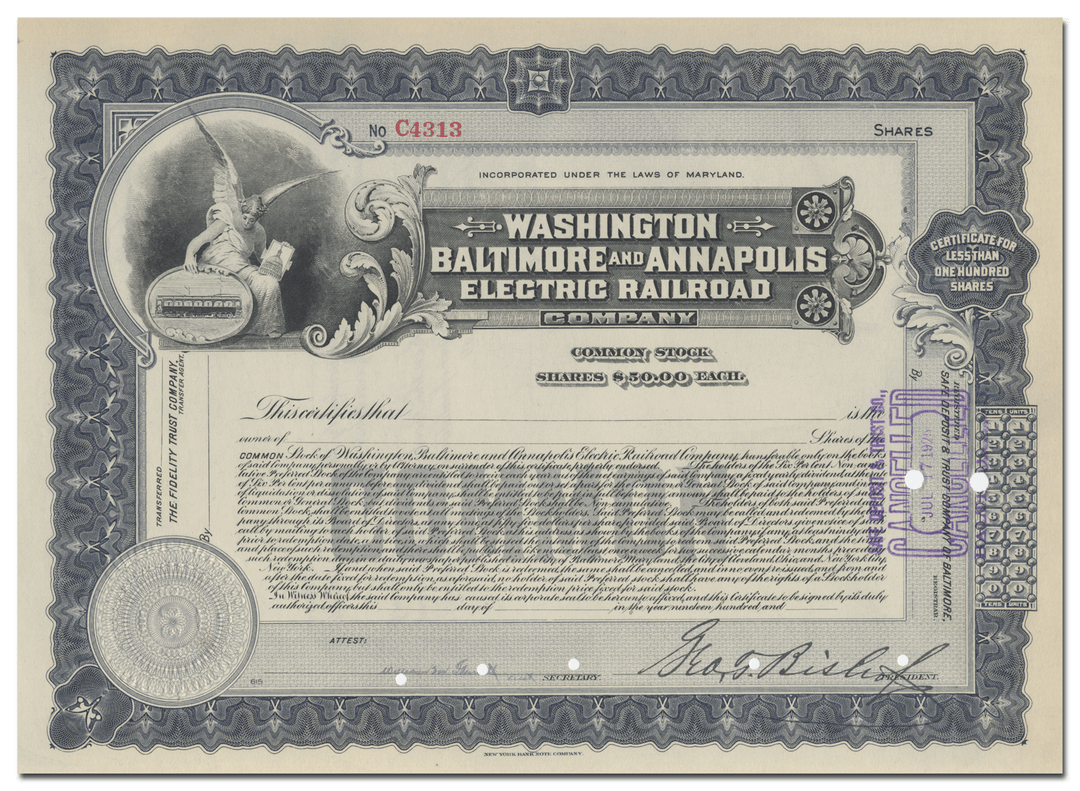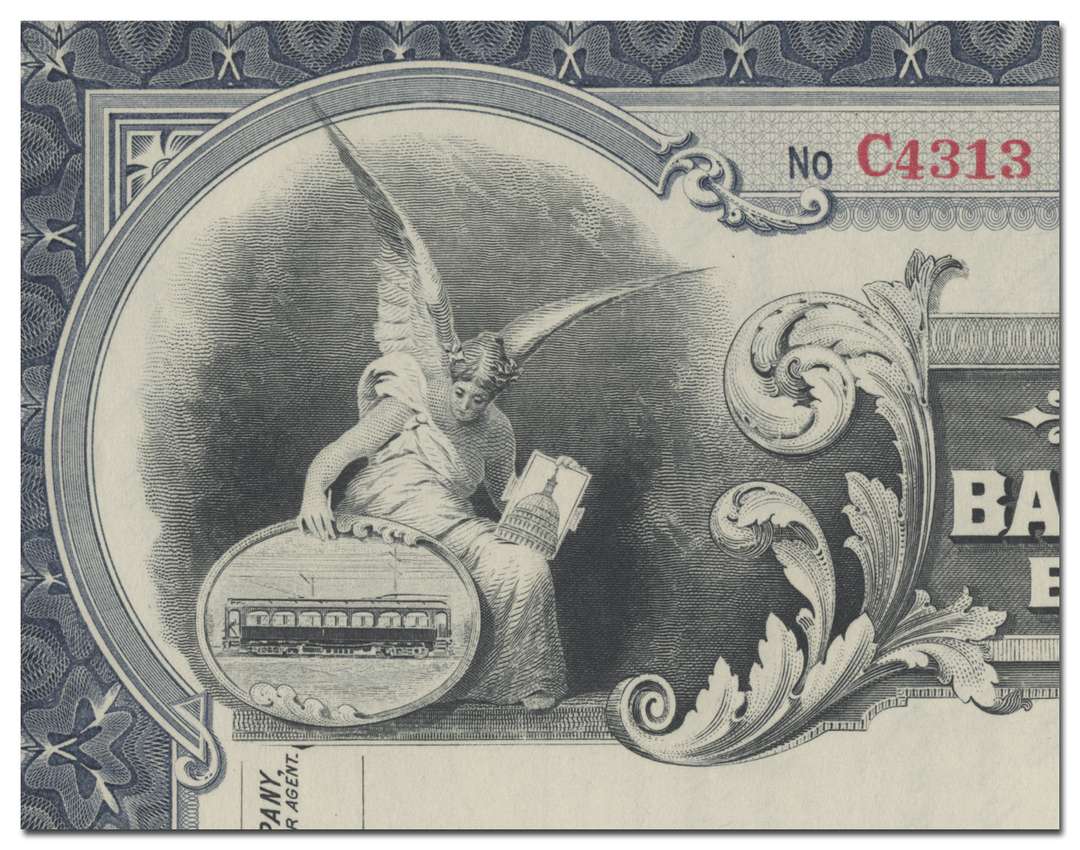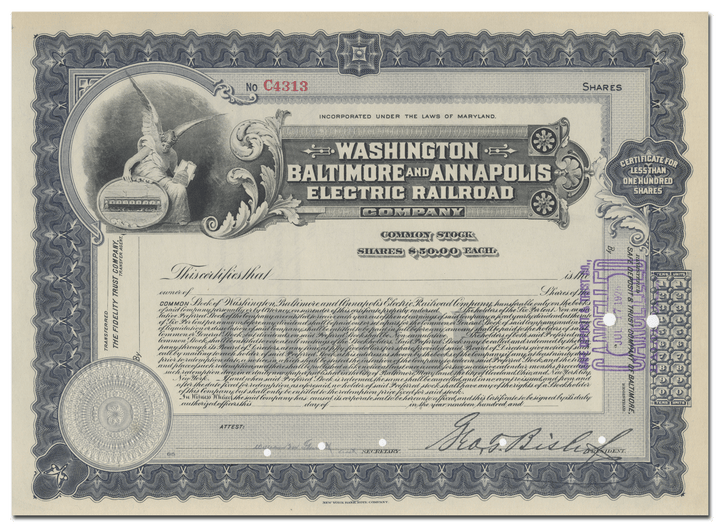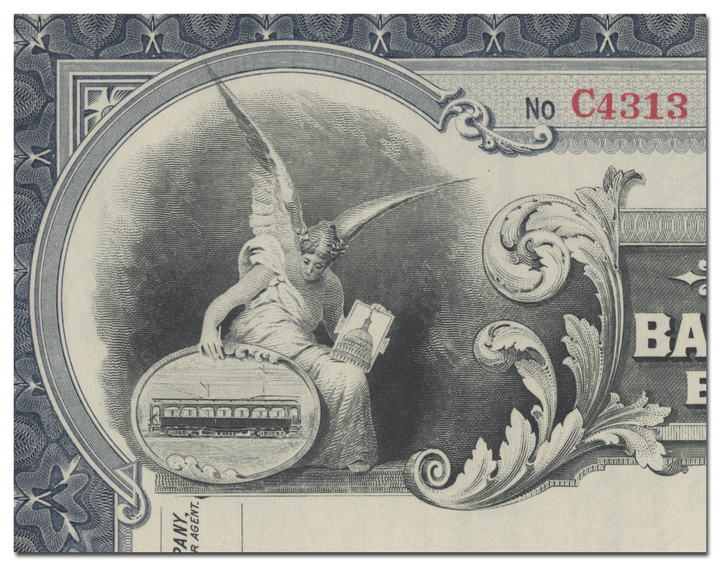Washington, Baltimore and Annapolis Electric Railroad Company (Signed by George Bishop)
- Guaranteed authentic document
- Orders over $75 ship FREE to U. S. addresses
Product Details
Company
Washington, Baltimore and Annapolis Electric Railroad Company
Certificate Type
Common Stock
Date Issued
Unissued, circa early 1900's
Canceled
Yes
Printer
American Bank Note Company
Signatures
Hand signed
Approximate Size
11" (w) by 8" (h)
Images
Representative of the piece you will receive
Guaranteed Authentic
Yes
Additional Details
Signed by George Bishop
Historical Context
The WB&A was originally incorporated in 1899 as The Potomac and Severn Electric Railway. On April 10, 1900, it changed its name to the Washington and Annapolis Electric Railway and finally, on April 8, 1902, to the Washington, Baltimore and Annapolis Electric Railway.
In 1903, the WB&A purchased the Annapolis, Washington & Baltimore Railroad (AW&B) - formerly the Annapolis & Elkridge Railroad - which was closed, electrified and reopened. At the same time, it laid an almost straight double-track route parallel to the B&O and Pennsylvania railroads, but slightly to the east in less populated territory. On February 7, 1908, service began from Liberty Street in Baltimore to its Washington terminal at 15th and H Streets NE. After 1910, the line reached the heart of downtown on 15th Street near the Treasury. Another single track began at the B&O main line at Annapolis Junction, crossed the WB&A main line just east of Odenton, and headed east via Millersville and Crownsville to Annapolis.
The line built by the WB&A, later called the Main Line, ran from Baltimore to Washington through Bowie, Glenn Dale Hospital, and Glenarden to Fairmont Heights where it met with the Chesapeake Beach Railway just outside Washington at Chesapeake Junction. From there, it continued to Deanwood on the Washington Railway and Electric Company's Seat Pleasant Line, running parallel to the Chesapeake Beach Railroad tracks and across the Benning Road Bridge into downtown Washington.
Once onto their own right-of-way, the WB&A’s expresses regularly hit 60 mph, but street running in the terminal cities slowed their overall time. A typical B&O express made the trip in 50 minutes, but the best the WB&A could do was an hour and 20 minutes. Offsetting these handicaps were its cleanliness, lower fares, half-hourly express service, and better-located downtown terminals.
In September 1917, as the U.S. entered World War I, George Bishop, who has signed this piece, the WB&A’s well-connected president, persuaded the U.S. Army to acquire land owned by the railroad and open a training facility. Camp Meade was established in the area roughly bounded by the B&O Washington Branch on the west, the Pennsylvania Railroad on the east, and the South Shore Line of the WB&A to the south. The installation was supposed to be a temporary facility, used only for the duration of the war (it is still in use today). The WB&A saw record traffic during this time as a result of freight and passenger service to the camp. In 1918, the railroad was running as many as 84 special trains a day.
Expansion
With the business seemingly successful, the WB&A purchased the Baltimore & Annapolis Short Line in 1921. It became known as the "North Shore Line" and the Annapolis to Odenton line as the "South Shore Line". At this time, the B&A gave up its terminus at the Camden Street Station of the Baltimore and Ohio Railroad and started using the WB&A terminal on Liberty Street (between Lexington and Fayette) in Baltimore. Prior to 1921 the WB&A and B&A had run on separate, parallel tracks from Linthicum to Baltimore. But on March 16, 1921, a crossover connected the two parallel tracks at Linthicum operations ceased on the B. & O. track, and a new terminal was built at the southwest corner of South Howard and West Lombard Streets (current site after the early 1970s of Holiday Inn hotel) across from the Baltimore Civic Center (1st Mariner Arena). The WB&A now consisted of 81 miles of track and the only practical way to get from Washington, D.C., to Annapolis.
Decline
Around the time of the purchase of the ASL, the Defense Highway was built providing an alternative route into Annapolis. As a result gross receipts for the railroad began to decline. The railroad only survived because of a law exempting it from taxes. In January 1931, during the Great Depression, the extension of the law failed to pass by one vote and the line went into receivership. The line remained in operation for four more years and was eventually sold at auction in 1935. Evans Products Company of Detroit negotiated to buy the railroad in June 1935, but those negotiations failed and the railroad officially ceased operations on August 20, 1935. Scrap dealers eventually bought most of the rolling stock. Evans bought the Arlington and Fairfax railroad the next year. Over time, the rails were hauled away, though by the beginning of World War II some remained and at least one post-War home in the area used old rails in lieu of I-beams. The right of way within Washington, D.C. remained under the ownership of WRECo and then the old Capital Transit Company. At some point between 1951 and 1956, the tracks in D.C. were removed.
The right of way of the North Shore Line and some equipment was bought by the Bondholders Protective Society, who then formed the Baltimore and Annapolis Railroad Company, which continued to operate rail passenger service between Baltimore and Annapolis until 1950 and freight service along with diesel passenger buses into the early 1970s to Brooklyn in South Baltimore, connecting with the #6 transit line for streetcars and buses of the old Baltimore Transit Company.
George Bishop

George Bishop's Signature
After the United States entered World War I in 1917 and Congress authorized the building of 16 cantonments (camps), George Bishop, thought land that Richard Respess envisioned as a major city between Baltimore and DC (the plan never got off the ground) would flourish as an installation.
"Not only was this vast land well suited for firing ranges and large maneuver areas, it was also situated equidistant between two large cities, bounded on both sides by main line railroads, and was located directly along the track of his own railway.”
After securing options or outright purchases from the original owners, the railroad company Bishop headed offered a proposal for an Army base at the village of Admiral.
On June 23, 1917, a general contract was signed for the construction of the camp. Actual construction began July 2. Within a year, the government bought more land, bringing the camp's total acreage to 9,400.
"Buildings appeared like mushrooms, oft times still surrounded by the remnants of last season's cornfield.”
The cantonment was named Camp Meade by War Department General Order 93, dated July 18, 1917, in honor of Maj. Gen. George G. Meade. Meade had led the Union forces to victory in the Battle of Gettysburg. Meade was chosen because many of the draftees trained here were from Pennsylvania, where Meade was a revered son.
Related Collections
Additional Information
Certificates carry no value on any of today's financial indexes and no transfer of ownership is implied. All items offered are collectible in nature only. So, you can frame them, but you can't cash them in!
All of our pieces are original - we do not sell reproductions. If you ever find out that one of our pieces is not authentic, you may return it for a full refund of the purchase price and any associated shipping charges.









